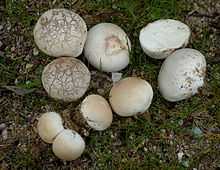Bovista aestivalis
| Bovista aestivalis | |
|---|---|
 | |
| Scientific classification | |
| Kingdom: | Fungi |
| Division: | Basidiomycota |
| Class: | Agaricomycetes |
| Order: | Agaricales |
| Family: | Agaricaceae |
| Genus: | Bovista |
| Species: | B. aestivalis |
| Binomial name | |
| Bovista aestivalis (Bonord.) Demoulin (1979) | |
Bovista aestivalis is a small puffball generally found in the coastal regions of California. This fungus is often confused with Bovista dermoxantha, because of its similar peridium, and Bovista plumbea. The surest way to tell the species apart is to examine the spores and exoperidium, respectively, with a microscope.[1]
Description
The fruit body is 1.5–3.0 cm broad and varies in shape from spherical to pulvinate (cushion-shaped). In addition, it is attached to the substrate by dense masses of hyphae. At first, the exoperidium is white; originally covered in dense filaments, it breaks up into buff, fine warts. With age, a brown, thin endoperidium becomes exposed underneath.[1] The spores are released via a ragged apical pore. The gleba is soft, changing from white, to olive and eventually medium-brown.[2]
The spherical| spores are 3.5–4.5 µm in diameter and moderately thick-walled with smooth warts. In the center lies an oil droplet and a stub-like pedicel. In addition, there is a capillitium from the central part of the gleba with numerous minute pits.[3]
Habitat
Bovista aestivalis is generally scattered and/or in small groups on edges of grassy areas along paths. They can also be found in coastal dunes among herbs and shrubs. When watered, they will fruit during the summer months and throughout the fall and winter after periods of rain. Because of their small size, they are often inconspicuous; despite their edibility, they are often too small to be of value.[4]
Synonyms
Obsolete synonyms for Bovista aestivalis include Bovista cepiformis (Bull.) Massee, Globaria furfuraceum (Schaeff.) Quel. 1873, Lycoperdon aestivale Bonord. 1851, Lycoperdon cepiforme Bull. 1791, Lycoperdon ericetorum var. cepiforme (Bull.) Bowerman 1961, and Lycoperdon furfuraceum Schaeff. 1770.[5]
References
- ↑ 1.0 1.1 Bates, S.T (2004). Arizona members of the Geastraceae and Lycoperdaceae (Basidiomycota, Fungi). Arizona State University. pp. 430–435. Retrieved 7-6-09. Check date values in:
|accessdate=(help) - ↑ Calonge, F.D. (1998). Flora Mycologica Iberica. Gasteromycetes, I. Lycoperdales, Nidulariales, Phallales, Sclerodermatales, Tulostomatales. 3. Berlin, Germany: J. Cramer. pp. 176–178. Check date values in:
|accessdate=(help); - ↑ Pegler, D.N., Læssøe, T. & Spooner, B.M. (1995). British Puffballs, Earthstars, and Stinkhorns. Royal Botanic Gardens: Kew, England. 255 p.
- ↑ Wood, Michael; Fred Stevens (1998). "Bovista aestivalis". Retrieved 2009-07-07.
- ↑ Bisby, F.A., Y.R. Roskov, M.A. Ruggiero, T.M. Orrell, L.E. Paglinawan, P.W. Brewer, N. Bailly, J. van Hertum, eds (2007). Species 2000 & ITIS Catalogue of Life: 2007 Annual Checklist. Species 2000: Reading, U.K.